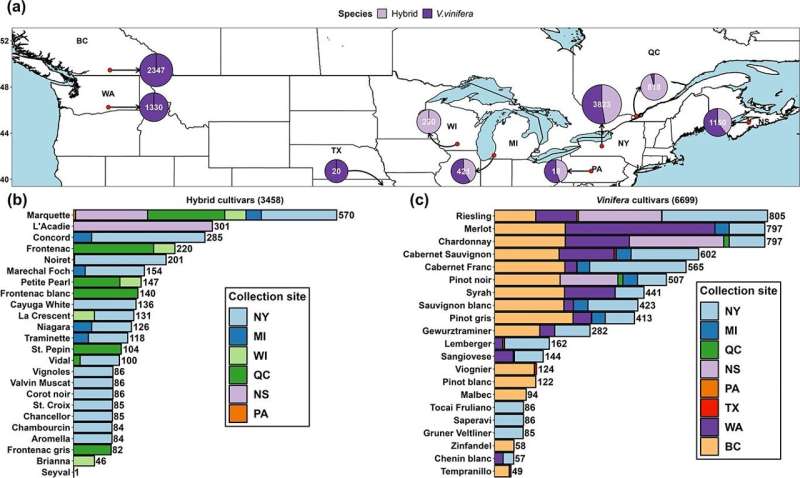This article has been reviewed according to Science X's editorial process and policies. Editors have highlighted the following attributes while ensuring the content's credibility:
fact-checked
trusted source
proofread
Computer model helps grape growers adapt to shorter winters

As the climate changes, winter is shortening, causing vines and trees to bud earlier in the year, thereby increasing the chances they will be exposed to spring cold snaps and frost that can be hazardous to yields.
A new Cornell-developed computer model that estimates the temperatures that cause freeze damage in a dozen grape cultivars can either ease growers' worries that no damage was likely done or help them to plan for the season when damage does occur.
The model, which is publicly available, has a web interface that allows Northeast users to select a weather station nearest to them from several thousand and choose from 12 grape cultivars to get a prediction within a couple of degrees of accuracy on whether their vines and especially the buds may have experienced freeze damage.
"If we have a freeze event that surpasses [a cultivar's] cold hardiness level, then the bud dies, and then you have an impact on harvest because the flower tissue is in the bud," said Jason Londo, associate professor in the School of Integrative Plant Science Horticulture Section in the College of Agriculture and Life Sciences. "If you kill that bud, it won't produce grapes for that season."
The model was developed by Hongrui Wang, a doctoral student whom Londo advises. A paper describing the cold hardiness prediction model was published in Horticulture Research.
Different grape cultivars are bred with different cold hardiness and that resilience changes in a U-shaped curve as winter progresses—each cultivar is tolerant to colder temperatures in the middle of winter and less tolerant to them at the start of winter and during spring.
The hardiest local cultivars, such as Cayuga White, developed at Cornell, or Marquette, a red wine grape developed at the University of Minnesota, can withstand temperatures as low as -20 degrees Fahrenheit in the middle of winter. A recently released Riesling hybrid, Aravelle, developed at Cornell AgriTech, can tolerate -7 degrees Fahrenheit without damage during midwinter.
But with warming spring temperatures, buds begin to open (called bud break), and green tissue pushes out. "That tissue has a much higher water content," Londo said, causing it to freeze at around 28 or 29 degrees Fahrenheit and making vines especially susceptible to spring frost events.
Londo and colleagues measure cold hardiness on 12 different varieties every week of the winter at Cornell AgriTech in Geneva, New York. They have been collecting grape cold hardiness data since 2009, which has informed the model. But the data they have collected applies to just one location, so Wang developed an application that allows users to input their local weather data and then get a prediction for their area based on the cultivar grown.
"A winter like this, the model is not all that useful because we really haven't had any cold," Londo said. "But going forward, if we were to have a cold event in March or April, users can go to our website, look at the model, and see whether it was cold enough to cause concern."
If the model predicts damage, a grower can then check buds with a razor blade and evaluate. Based on the extent of and timing of the damage, growers may prune less and leave more buds on the vine than they normally would to balance out expectations.
If a grower normally leaves 10 buds on a vine, and a freeze event causes 50% damage, then the grower may leave 20 buds this time in hopes of compensating for some of the damage. Alternately, if the damage is very severe, they may then plan the rest of the season with that knowledge, prompting them to seek crop insurance or source some of their fruit from elsewhere.
In the future, Londo and colleagues will continue to monitor grape cultivar cold hardiness every year. They are working with collaborators in Canada and across the Northeast to verify the model works everywhere. They are also trying to understand the genetics that may enhance cold hardiness and slow bud break.
"As the climate gets warmer, bud break comes earlier, but frost risk doesn't go down," Londo said. "So we're working to understand what happens when buds freeze in general so that we can come up with new technologies to give us mitigation methods as the climate gets more and more chaotic," he said.
More information: Hongrui Wang et al, NYUS.2: an automated machine learning prediction model for the large-scale real-time simulation of grapevine freezing tolerance in North America, Horticulture Research (2023). DOI: 10.1093/hr/uhad286
Provided by Cornell University





















